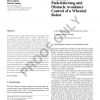Free Online Productivity Tools
i2Speak
i2Symbol
i2OCR
iTex2Img
iWeb2Print
iWeb2Shot
i2Type
iPdf2Split
iPdf2Merge
i2Bopomofo
i2Arabic
i2Style
i2Image
i2PDF
iLatex2Rtf
Sci2ools
IJRR
2007
2007
Combined Path-following and Obstacle Avoidance Control of a Wheeled Robot
This paper proposes an algorithm that drives a unicycle type robot to a desired path, including obstacle avoidance capabilities. The path-following control design relies on Lyapunov theory, backstepping techniques and deals explicitly with vehicle dynamics. Furthermore, it overcomes the initial condition constraints present in a number of path-following control strategies described in the literature. This is done by controlling explicitly the rate of progression of a “virtual target” to be tracked along the path1 thus bypassing the problems that arise when the position of the path target point is simply defined as the closest point on the path. The obstacle avoidance part uses the Deformable Virtual Zone (DVZ) principle. This principle defines a safety zone around the vehicle in which the presence of an obstacle induces an “intrusion of information” that drives the vehicle reaction. The overall algorithm is combined with a guidance solution that embeds the path-following requi...
| Added | 15 Dec 2010 |
| Updated | 15 Dec 2010 |
| Type | Journal |
| Year | 2007 |
| Where | IJRR |
| Authors | Lionel Lapierre, René Zapata, Pascal Lépinay |
Comments (0)

